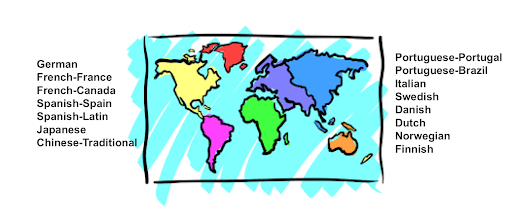Would you trust someone you don’t understand? I’m sure most of you answered “No.” To establish trust in something, we expect it to be true and reliable. Understanding is the first step in building that trust.

Historically, data languages have been the lingua franca of analytics. But as search and AI-driven analytics become the norm, everyday business users are able to interact with data directly through a simple, natural language.
So why limit BI to English speakers only? How about a BI tool that lets you analyze your data in your very own language?
Here at ThoughtSpot, it’s been our mission to create a more fact-driven world. And that means making ThoughtSpot available to companies, organizations, and people around the world, in the language they already know. That’s why today, we’re excited to announce ThoughtSpot is now available in 15 languages listed here, in addition to English-US, English-UK and English-Canada.

You can now search your data in your very own language. All the answers, insights, and analyses are presented in your native locale and formats. Further, the ThoughtSpot UI automatically responds to your location to display all your favorite pinboards, answers and other artifacts in the correct language to enable collaboration across users, no matter where in the world they happen to be.

Switching between languages takes just a few clicks
Building the Polyglot ThoughtSpot
While we’ve always known ThoughtSpot would be a global product, the journey building to today wasn’t easy. But we stuck to one of our key product principles - we build platforms for the long-term.
Some of the notable efforts to getting here include:
Neutral code: We write language independent code and ensure that all localizable content is externalized out of the code. This allows us to add or update any language without having to make any changes to the code
Date/Currency/Numbers: Taking into consideration that different languages represent the date, currency, and numbers in different formats, ThoughtSpot depicts these as per the user’s ThoughtSpot locale, with a fall back to the browser locale.
Pseudo Localization: We have a pseudo localization process in place, which lets us emulate a non-English environment where we can verify the feature before we even get it translated. Furthermore, we don’t require lingual expertise to work with pseudo; it’s solely for internal QA verification purposes.

Sample pseudo localized UI.
ThoughtSpot Search: The secret sauce of ThoughtSpot is our search-driven analytics. All the search keywords are available in each of the supported locales. For example, say you need to search for revenue for last 3 years, sorted by the entity name with a detailed date. Your typical search in English will be “name revenue last 3 years sort by name date detailed”. In German, it would be “name revenue letzte 3 jahre sortieren nach name date detailliert”, while in Japanese you’d use “name revenue 過去 3 年 次で並べ替え name date 詳細“, where “name” , “date” and “revenue” are the column names of the underlying dataset and “last 3 years” ,“sort by” and “detailed” are search keywords.<br><br>


Example search with numbers and dates in German
There are few cases when a word to word translation wouldn’t make sense. In such cases, we translate on a phrase level instead of a word level. This helps to change the structure as per language’s grammar, while ensuring the results remain consistent. For example, if the English search is “last 2 months for each quarter” the Japanese search is “四半期毎の最後の 2 か月”. So you see how intelligently the words in the phrase get repositioned in order to comply with the structure of the Japanese language.<br>

Automated Insights: Our AI assistant is language neutral; it provides insights based on the underlying data independently of the user’s locale. So while insights remain exactly the same, they will be presented as per the user locale. Below is a SpotIQ insights report for the same set of data in English and Japanese. As you can see the insights are exactly the same but depicted in the corresponding locale giving the user a more local experience.<br> <br>


UNICODE all the way: ThoughtSpot uses UNICODE throughout our platform, which makes it possible to handle data in any language.
Cloud Hosted Translations: At ThoughtSpot, we engage highly reputed translation agencies who provides high quality, in context translations. However for a few high impact features/messages, such as the insights titles, search keywords, and email notifications, we leverage our in-region employees because of their unique blend of native language expertise, customer experience, and analytics domain skills. Translations happen in a continuous cycle at a regular cadence, which ensures we keep up and stay aligned to the ongoing releases.<br>

Lingual Verifications: Verification of the translated content is performed by the native speakers either in-house or in the vendor team. Any Lingual updates are taken up and fixed within a day, since we have the cloud model independent of the product code in place.
With the above efforts in place, a new language can be easily plugged into ThoughtSpot with minimal effort, helping us bring search & AI-driven analytics to people all around the world!







